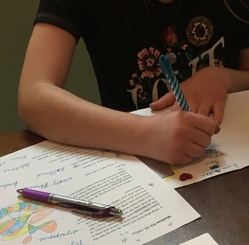WORSHIP ENGAGEMENT, PART 1
Some thoughts about engaging and equipping children to sit through a full worship service.
Our first response is to give these children something to keep them busy and entertained. A phone or tablet with a movie or video game will certainly distract a child - to the point that he or she is no longer a participant in the worship service. So what about “busy bags” as a solution?
I am troubled by the idea of "busy bags" or even "activity bags" as I think those words imply that we need to keep children busy during a worship service because they cannot worship. Instead, let’s consider ways to engage children in worship, in a developmentally appropriate way.
The Bible doesn’t say we have to pray sitting still, with our hands folded and our eyes closed. Scripture reading doesn’t have to be boring. If we want kids to connect with God and His Word in a meaningful way, we must help them.
The first step in engaging children in worship is:
- For parents to let children know what is expected of them during worship. Expectations will vary with the age of the child and the situation.
- Perhaps children should stand during the hymns, even if they can’t read the words (over time they will learn the words by hearing them repeatedly in worship, or you can pick a few favorites and play them in the car or at home).
- Or maybe your child can dance in place or play a quiet rhythm instrument along with the music (egg shakers are relatively quiet and cheap).
- Children can understand from a young age that times of prayer are times for quiet stillness and can be taught that those times are not when they should ask whispered questions.
- Children can memorize the Lord’s Prayer and pray it with the congregation.
- However, sitting perfectly still is not an expectation that makes sense for young children in worship. Research shows that physical activity — even a little foot-tapping or gum chewing — increases levels of the neurotransmitters in the brain that control focus and attention.
- A subtle fidget may help block out distractions and fight boredom.
- An effective fidget doesn’t distract from the primary task (worship) because it is something the child doesn’t have to think about.

- For example, doodling while sitting in a meeting or listening to a sermon enables you to better absorb what’s being said. Experiment with a variety of strategies; encourage your child to try different fidgets such as swinging her feet in her too big chair or squeezing his soft toy or fiddling with her ring or making shapes with pipe cleaners or coloring a Bible story picture.
- Being attentive during the sermon seems like a particularly daunting task. But a little planning and preparation can help your children not only be quiet, but also help them engage in the Word being preached.
- Before worship, read the sermon Scripture with your children (if this is not normally provided in advance, ask your pastor for help with this).
- Take a few moments before the service starts to review the student worship guide with your prereaders to give them instruction on what they will be hearing and what they can work on or think about during the sermon.
- Hearing and thinking about the scripture in advance will help children engage in the scripture/sermon using Lego or Play Doh or pipe cleaners or Scripture Doodling to create something that reminds them of what they are hearing.
- Then, after worship, take time to process with your children what they heard and how they responded.
- Have them tell you about their creations.
- Ask them to retell the story using Lego.
- Help them finish the puzzle in the worship guide.
- Talk about the sermon points over lunch.
- Share how you plan to apply what you heard in the coming week.
- These actions will make worship a part of everyday life during the week, not just a weekly interruption.
For more suggestions of activities that encourage active listening, see this blog post by Christie Thomas.
By the way, are you wondering WHY we are working so hard to include children in worship? Jesus himself welcomed children and told us to be like them. We were all (from birth) created to worship and glorify God. The experience of being in a worship service immersed in practices that have been formational for generations and being with the people who make up the body of Christ is important to share as a family. Children will feel a sense of belonging and will know they have a place in our community. Here is a good article by Christina Embree summarizing recent findings on the importance of intergenerational worship.



